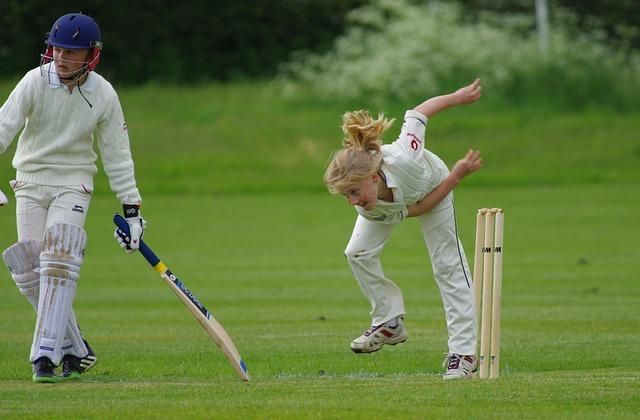- Advertisement -
Cricket, long regarded as a quintessentially male-dominated sport and often described as a “gentleman’s game,” is witnessing a transformative shift as increasing numbers of girls take to the pitch. The evolving landscape signals not only growing opportunities and recognition for female cricketers but also a broader cultural change challenging traditional gender norms in sports. With grassroots programs, expanded media coverage, and more institutional support than ever before, women’s cricket is stepping firmly into the spotlight, reshaping the narrative of the game in India and beyond.
Rising Participation of Girls in Cricket Reshapes the Sport’s Traditional Image
Traditionally perceived as a sport dominated by men, cricket is witnessing a transformative wave as increasing numbers of girls are stepping onto the pitch. This surge in female participation is not only challenging gender norms but also enriching the game with fresh perspectives and unparalleled enthusiasm. Schools and cricket academies across the country report a steady rise in girl players registering for coaching camps, signaling a shift from mere curiosity to serious commitment. The impact extends beyond grassroots levels, with more women featuring prominently in local clubs and competitive leagues, gaining attention from mainstream media and sponsors alike.
Key factors contributing to this rise include:
- Enhanced access to training facilities and resources tailored for girls.
- Increased visibility of women cricketers inspiring the next generation.
- Supportive initiatives by cricket boards promoting gender inclusivity.
- Community programs encouraging sports participation among young girls.
| Year | Girls’ Registered Players (in thousands) | Women’s Cricket Leagues Established |
|---|---|---|
| 2018 | 8 | 3 |
| 2019 | 14 | 5 |
| 2020 | 22 | 7 |
| 2021 | 31 | 10 |
| 2022 | 45 | 14 |
The evolving landscape of cricket now reflects a more inclusive spirit where talent and determination transcend gender boundaries. As more girls rise through the ranks, the sport is shedding its exclusive “gentleman’s game” label, promising a future where women’s cricket not only thrives but also redefines the cultural fabric of the game worldwide.
Breaking Barriers and Building Pathways for Women Cricketers Across India
Across India, cricket is rapidly shedding its label as a “gentleman’s game,” with more young women stepping onto the pitch and redefining the sport. Grassroots programs, increased media coverage, and institutional support from organizations like the BCCI have played vital roles in nurturing female talent. Regions once considered cricketing backwaters now boast thriving women’s leagues, while schools and academies are actively encouraging girls to pursue the game professionally. This surge reflects a broader cultural shift, with families and communities embracing women’s participation in sports like never before.
Key factors driving this transformation include:
- Improved infrastructure: Access to quality training facilities tailored for women athletes.
- Sponsorship and endorsements: Brands stepping forward to back female cricketers’ journeys.
- Role models: Trailblazers like Harmanpreet Kaur inspiring the next generation of players.
- Media Coverage: Extensive live broadcasts and social media presence elevating women’s cricket.
| Region | Number of Women’s Cricket Clubs | Annual Growth Rate (%) |
|---|---|---|
| North India | 120 | 18 |
| South India | 95 | 22 |
| East India | 75 | 15 |
| West India | 110 | 20 |
Recommendations for Enhancing Infrastructure and Support Systems to Foster Female Talent
To cultivate a vibrant ecosystem that champions female cricketers, it is essential to develop robust infrastructure tailored specifically to their needs. This includes establishing dedicated training facilities equipped with the latest technology and coaching staff who specialize in women’s cricket. Access to quality practice pitches, strength and conditioning centers, and sports medicine units will significantly enhance performance levels. Additionally, creating safe, well-maintained changing rooms and accommodation options close to cricket grounds can encourage more girls to pursue the sport professionally, ensuring that logistical barriers do not hinder their progress.
Support systems must also evolve to foster sustainable growth. Grassroots programs targeting young girls in schools and communities, combined with scholarship initiatives, will help nurture talent early on. Equally important are mentorship networks connecting aspiring players with established female cricketers, providing guidance and motivation. Below is a snapshot of key recommendations that stakeholders should prioritize:
- Investment in women-only academies and leagues
- Regular talent scouting camps across rural and urban areas
- Enhanced media coverage and marketing of women’s matches
- Workshops on mental health and career management
- Collaboration between cricket boards and educational institutions
| Area | Current Status | Recommended Action |
|---|---|---|
| Training Facilities | Limited access | Dedicated women-centric centers |
| Scholarships | Minimal availability | Nationwide programs |
| Coaching Staff | Low female representation | Specialized hiring and training |
| Media Exposure | Underrepresented | Regular coverage & campaigns |
In Retrospect
As the number of girls stepping onto cricket grounds continues to rise, the sport is shedding its long-held image as solely a “gentleman’s game.” With increasing support from schools, clubs, and governing bodies, women’s cricket is gaining momentum and visibility across the country. This shift not only broadens the talent pool but also challenges traditional norms, signaling a more inclusive and diverse future for cricket in India. As the boundaries of the game expand, so too does the opportunity for aspiring female cricketers to make their mark on the national and international stage.
- Advertisement -


